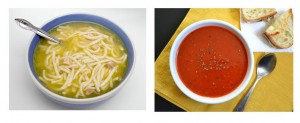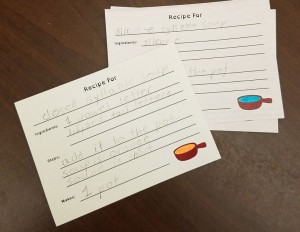Understanding that syllables come in different types – closed, open, silent-e, r-controlled, vowel team, consonant-le – is an important part of analyzing words. But have you ever had a student who just never quite gets what you mean when you ask what the “syllable type” is? Here’s a strategy I use that helps bring a tactile component to this sometimes hard to grasp concept.
I start the discussion by talking about soup. It comes in different types, and I ask my student to tell me some different types of soup. Chicken noodle, tomato, vegetable, potato. Just like soup comes in types that look and taste different, syllables come in types that look and sound different from each other.
Now ask them, if I gave you a bowl of soup and asked you to figure out what kind it is, how would you do it? They’d look at what color it was, poke around to see what ingredients were in the bowl, and maybe taste or smell it. You can do the same thing with syllables! Well, maybe not taste or smell, but you can use the “ingredients”, color and sound to figure out what type it is.
As you introduce each syllable type, help your student discover what the “ingredients” are that identify what kind of syllable it is. These will be the ingredients needed in your recipe. For a closed syllable, the ingredients will be 1 vowel letter and 1 or more tail letters.
I also assign colors to the various vowel sounds so that the soups can look different based on their sounds as well (highlighters work great to color in the pot on the recipe card!):
short is orange
long is blue
nasal blend is green
r-control is pink
wrestling vowel team is purple
This has been incredibly helpful in giving concrete terminology (it’s orange) to supplement more abstract wording (it’s “short”). It’s also helpful in showing that different recipes can make the same color “soup”…open, silent-e and walking vowel teams may have slightly different ingredients, but they all make blue soup, since they all make a long vowel sound.
Have them fill out a recipe card with the name of the “Syllable Soup”, it’s ingredients, the steps to “make” the recipe, and to color in the pot to give a visual indication of the soup color.
Each recipe makes “one pot” of soup, since every syllable (pot) can potentially be a different type (recipe). I actually bring in some real pots, and use magnetic letters to “make” the recipe. Once you get into multiple syllables, you can also use the pots to show how each syllable needs it’s own pot and recipe.
Now when you want a student to identify a syllable’s syllable type, you can simply ask…what recipe is it? If they have trouble, have them compare the “ingredients” in the word to the ingredients in the recipes to find a match. For auditory, you can ask…what color is it?
I created some blank recipe cards, and actually have my students fill them out with the “recipe” every time they learn a new syllable type. Here are the Blank Syllable Types Recipe Cards.
Here are the “Syllable Soup Recipes” that show what ingredients and steps you can have your students write onto their recipe cards.


